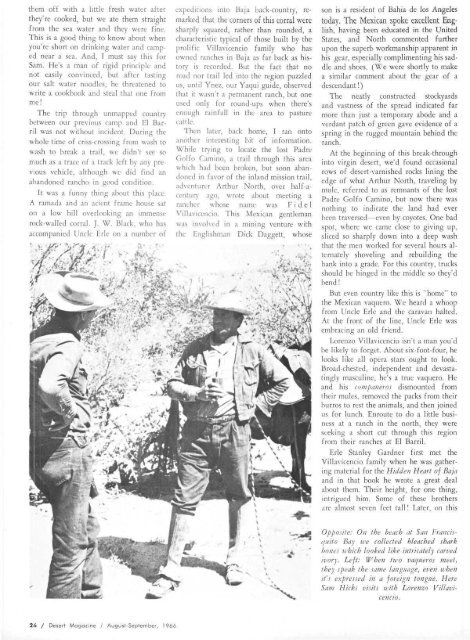AUGUST/SEPTEMBER 1 9 6 6 double issue - Desert Magazine of ...
AUGUST/SEPTEMBER 1 9 6 6 double issue - Desert Magazine of ...
AUGUST/SEPTEMBER 1 9 6 6 double issue - Desert Magazine of ...
You also want an ePaper? Increase the reach of your titles
YUMPU automatically turns print PDFs into web optimized ePapers that Google loves.
them <strong>of</strong>f with a little fresh water after<br />
they're cooked, but we ate them straight<br />
from the sea water and they were fine.<br />
This is a good thing to know about when<br />
you're short on drinking water and camped<br />
near a sea. And, I must say this for<br />
Sam. He's a man <strong>of</strong> rigid principle and<br />
not easily convinced, but after tasting<br />
our salt water noodles, he threatened to<br />
write a cookbook and steal that one from<br />
me!<br />
The trip through unmapped country<br />
between our previous camp and El Barnl<br />
was not without incident. During the<br />
whole time <strong>of</strong> criss-crossing from wash to<br />
wash to break a trail, we didn't see so<br />
much as a trace <strong>of</strong> a track left by any previous<br />
vehicle, although we did find an<br />
abandoned rancho in good condition.<br />
It was a funny thing about this place.<br />
A ramada and an acient frame house sat<br />
on a low hill overlooking an immense<br />
rock-walled corral. J. W. Black, who has<br />
accompanied Uncle Erie on a number <strong>of</strong><br />
26 / <strong>Desert</strong> <strong>Magazine</strong> / August-September, 1 966<br />
expeditions into Baja back-country, remarked<br />
that the corners <strong>of</strong> this corral were<br />
sharply squared, rather than rounded, a<br />
characteristic typical <strong>of</strong> those built by the<br />
prolific Villavicencio family who has<br />
owned ranches in Baja as far back as history<br />
is recorded. But the fact that no<br />
road nor trail led into the region puzzled<br />
us, until Ynez, our Yaqui guide, observed<br />
that it wasn't a permanent ranch, but one<br />
used only for round-ups when there's<br />
enough rainfall in the area to pasture<br />
cattle.<br />
Then later, back home, I ran onto<br />
another interesting bit <strong>of</strong> information.<br />
While trying to locate the lost Padre<br />
Golfo Camino, a trail through this area<br />
which had been broken, but soon abandoned<br />
in favor <strong>of</strong> the inland mission trail,<br />
adventurer Arthur North, over half-acentury<br />
ago, wrote about meeting a<br />
rancher whose name was Fidel<br />
Villavicencio. This Mexican gentleman<br />
was involved in a mining venture with<br />
the Englishman Dick Daggett, whose<br />
son is a resident <strong>of</strong> Bahia de los Angeles<br />
today. The Mexican spoke excellent English,<br />
having been educated in the United<br />
States, and North commented further<br />
upon the superb workmanship apparent in<br />
his gear, especially complimenting his saddle<br />
and shoes. (We were shortly to make<br />
a similar comment about the gear <strong>of</strong> a<br />
descendant!)<br />
The neatly constructed stockyards<br />
and vastness <strong>of</strong> the spread indicated far<br />
more than just a temporary abode and a<br />
verdant patch <strong>of</strong> green gave evidence <strong>of</strong> a<br />
spring in the rugged mountain behind the<br />
ranch.<br />
At the beginning <strong>of</strong> this break-through<br />
into virgin desert, we'd found occasional<br />
rows <strong>of</strong> desert-varnished rocks lining the<br />
edge <strong>of</strong> what Arthur North, traveling by<br />
mule, referred to as remnants <strong>of</strong> the lost<br />
Padre Golfo Camino, but now there was<br />
nothing to indicate the land had ever<br />
been traversed—even by coyotes. One bad<br />
spot, where we came close to giving up,<br />
sliced so sharply down into a deep wash<br />
that the men worked for several hours alternately<br />
shoveling and rebuilding the<br />
bank into a grade. For this country, trucks<br />
should be hinged in the middle so they'd<br />
bend !<br />
But even country like this is "home" to<br />
the Mexican vaquero. We heard a whoop<br />
from Uncle Erie and the caravan halted.<br />
At the front <strong>of</strong> the line, Uncle Erie was<br />
embracing an old friend.<br />
Lorenzo Villavicencio isn't a man you'd<br />
be likely to forget. About six-foot-four, he<br />
looks like all opera stars ought to look.<br />
Broad-chested, independent and devastatingly<br />
masculine, he's a true vaquero. He<br />
and his companeros dismounted from<br />
their mules, removed the packs from their<br />
burros to rest the animals, and then joined<br />
us for lunch. Enroute to do a little business<br />
at a ranch in the north, they were<br />
seeking a short cut through this region<br />
from their ranches at El Barril.<br />
Erie Stanley Gardner first met the<br />
Villavicencio family when he was gathering<br />
material for the Hidden Heart <strong>of</strong> Bajn<br />
and in that book he wrote a great deal<br />
about them. Their height, for one thing,<br />
intrigued him. Some <strong>of</strong> these brothers<br />
are almost seven feet tall! Later, on this<br />
Opposite: On the beach at San Francis-<br />
(jii'ito Bay we collected bleached shark<br />
bones which looked like intricately carved<br />
ivory. Left: When two vaqueros meet,<br />
they speak the same language, even when<br />
it's expressed in a foreign tongue. Here<br />
Sam Hicks visits with Lorenzo Villavicencio.

















